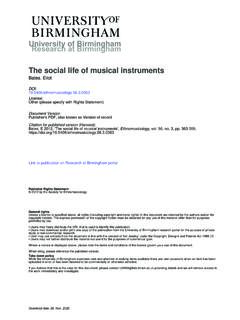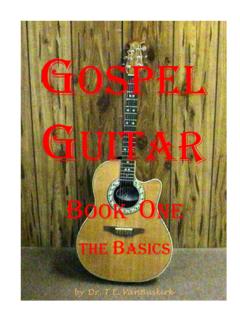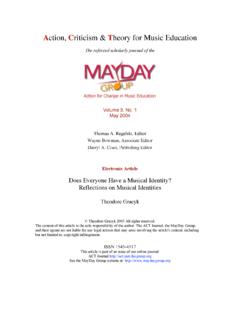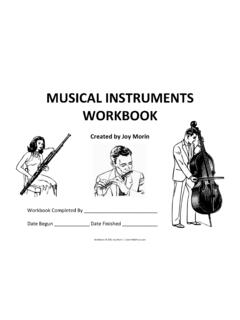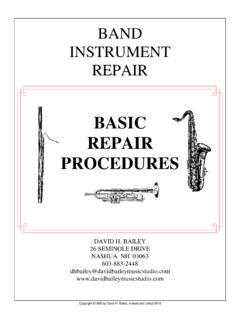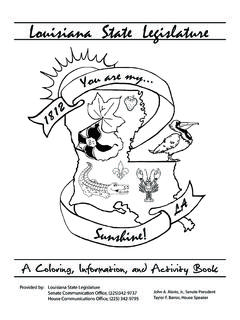Transcription of Student Guide for SOLO-TUNED HARMONICA (Part I — …
1 Student Guide forSOLO- tuned HARMONICA (Part I Diatonic)Presented byThe Gateway HARMONICA Club, Louis, MissouriTo participate in the course SOLO-TUNED HARMONICA (Part I Diatonic), the studentmust have: a 12-hole SOLO-TUNED diatonic HARMONICA in the key of C, or a 12- or 16-hole chromatic HARMONICA in the key of of the material covered in this course pertains to the SOLO-TUNED diatonic students using 12- or 16-hole SOLO-TUNED chromatic harmonicas will be able toplay the same material and use the same techniques; however, the additionalcapabilities of the chromatic HARMONICA will not be course is designed to teach beginner level players the basics of playing the 12-holesolo- tuned diatonic HARMONICA , which is tuned differently from the standard 10-holediatonic instrument.
2 !Although SOLO-TUNED instruments are not well suited for bluesplaying, they are ideal for playing melodies and are simpler to in this course will learn: basic playing technique where the notes of the major diatonic scale are located on the solo -tunedharmonica, and how to use this knowledge in playing a number of familiar of scales, pitch and rhythm will be who complete this course may wish to take SOLO-TUNED HARMONICA (Part II Chromatic), for which the Student must have a 12- or 16-hole SOLO-TUNED chromaticharmonica in the key of TO THE HARMONICAW elcome to the world of HARMONICA playing. The HARMONICA is a very special musicalinstrument. It s small, inexpensive and easy to learn to play.
3 It can be used to playanything from nursery rhymes to classical music. It has a very special sound. You canuse it to play simple songs or complex songs, old songs or modern don t need years of music lessons to begin to enjoy your HARMONICA . With a coupleof lessons and a few minutes of practice each day, you should be playing simple tunesin no time. And if you continue to learn and practice new songs, you can become anexpert this course you will learn some important basic facts and skills, including: How to play a single note How to play each note of the C major scale How to relate the notes on your HARMONICA to standard written music How to play songs from standard written musicWHEN YOU HAVE FINISHED THE COURSE.
4 You will have the ability to learn and play many additional songs that you can findin books available at music stores, schools, churches and libraries. Some of these booksare written specially for HARMONICA players. Others are written for voice or for suchother instruments as piano, flute or that you find in some books may contain certain in-between notes (calledsharps and flats) that are not built into the kind of HARMONICA that you have. Otherharmonicas (called chromatic harmonicas ) are designed to play those in-between notes. If you reach a point in your HARMONICA playing where you want to be able toplay a wider variety of songs, you may decide to purchase a chromatic TO HOLD YOUR HARMONICA WHEN PLAYINGThe way you hold your HARMONICA is in some ways a matter of choice and a result ofhabit.
5 Any hand position that is comfortable to you and produces the sound you like isright for you. However, as a beginning player, you should at least try the hand positionillustrated below. It has proved effective for many : The cover plate with the hole numbers should be on position allows the right hand to cup around the bottom and back of theinstrument, producing a sweeter, muted tonal quality when the cup is closed and abrighter tone when the cup is YOUR HARMONICA MAKES SOUNDSB efore you learn to play your HARMONICA , it is helpful to understand a few basic factsabout how a HARMONICA makes sound. Knowing these facts will help you to playcorrectly and to take good care of your HARMONICA plays musical sounds (tones) when you blow (exhale) or draw (inhale) airthrough the holes at the front of the : Blow through some of the holes on your HARMONICA .
6 Then draw throughthe same : Are the tones played when you blow different from the tones playedwhen you draw? _____EXERCISE: Take a big breath. Then blow into the holes on the left end of theharmonica (holes 1,2,3, etc.) While you are still blowing, slide the HARMONICA to the leftso that your mouth slides to the right end of the HARMONICA . Repeat, but this time slideyour mouth from right to : (fill in the blanks) The low tones are on the _____ end and the hightones are on the _____ :For information on how harmonicas are made, see page PLAYING ONE NOTE AT A TIMEWhen you blow or draw air through two or more holes at the same time, you play twoor more notes together. Sometimes this makes the musical sound you want, but somenotes when played together make an unpleasant or musically incorrect sound.
7 Toavoid this, you need to learn a technique for playing one note at a are two basic techniques for playing one note at a time. One is called the tongueblocking method, and the other is called the pucker method. Which one shouldyou use? The one that works better for you. The size and shape of your mouth and theflexibility of your lip muscles will determine which method you find more effective ingetting the sound you use the tongue-blocking method, place your lips over three or four holes and holdyour tongue against the holes on the left side, leaving room to blow or draw air next tothe right side of your use the pucker method, form a small opening with your lips as you would forwhistling or sipping through a straw. Then press your lips to the : Try both of these methods and see which one works best foryou in playing one note at a time.
8 If you can t seem to get the result youwant with either method, don t be discouraged. Some players find that ittakes a while to develop a good single note technique. Just keep workingat it and do the best you can. With practice, you will develop your owntechnique for playing single IS solo -TUNING ALL ABOUT?This course is based on the use of the 12-hole SOLO-TUNED diatonic model harmonicatuned in the key of C . The term SOLO-TUNED refers to an arrangement of the notes thatis more convenient for using a single-note technique to play melodies. (The morecommon tuning used on most 10-hole harmonicas is called Richter tuning. It wasdesigned about a century ago for a multi-note approach to playing the folk tunes of thatperiod.)
9 It is still used today by many blues, folk and country music players.)SCALESA scale is an ascending sequence of musical tones or A diatonic scale is asequence of eight tones spanning an octave (as explained in the next section). There aremany different diatonic scales, but probably the most familiar one in Western culture isthe major scale, the one many of us learned as children in school. We learned to sing itusing syllable names for the pitches:do re mi fa so la ti first tone and last tone in this sequence are given the same name, do, because theysound nearly identical even though the second one is higher in : Blow in hole 1. Blow in hole 5. Blow in hole 9. Blow inhole 12. Can you tell that all of these tones sound very similar,although not identical?
10 Actually, the second do, in addition to being the last tone of the scale shown above, isthe first tone of another major scale that repeats the same sequence of eight tones:do re mi fa so la ti do re mi fa so la ti doOCTAVEAs seen above, the major scale consists of eight pitches or musical name for the difference in pitch between any two tones is interval . Themusical name for the interval between the two dos in the above scale or between anytwo tones that are eight tones apart is octave .6 LETTER NAMES OR NOTE NAMESIn addition to the syllable names (do, re, mi, etc.) shown above, all musical tones alsohave letter names. These letter or note names are the names we will learn to use in thisharmonica course. On your HARMONICA , which is tuned in the key of C , the letternames that correspond to do, re, mi, etc.
